Improving Intermediate Temperature Plasticity of Co–Al–W–Base Superalloy: Based on Optimizing MC Carbides
Abstract
:1. Introduction
2. Materials and Methods
3. Results
3.1. MC Carbide Characteristics
3.2. Effect of MC Carbides on Deformation Behavior of the Superalloy at 800 °C
3.3. High-Temperature Ductility Evaluation of the Superalloy by MC Carbides
4. Conclusions
- (1)
- A Co–Al–W–base superalloy that consisted of γ–Co, γ’–Co3(Al, W), and MC carbide was developed;
- (2)
- MC carbide breakers are the source of microcracks, and directly affect the plasticity of Co–Al–W–base superalloy at 800 °C;
- (3)
- MC carbide breakers appear after yielding. It is mainly dependent on the morphology and the size of the MC carbides. Fractures along the length direction and the width direction are two primary fracture paths of MC carbides;
- (4)
- The intermediate temperature plasticity of the Co–Al–W–base superalloy can be guaranteed by controlling the critical size of MC carbides.
Author Contributions
Funding
Data Availability Statement
Conflicts of Interest
References
- Sato, J.; Omori, T.; Oikawa, K.; Ohnuma, I.; Kainuma, R.; Ishida, K. Cobalt-Base High-Temperature Alloys. Science 2006, 312, 90–91. [Google Scholar] [CrossRef] [PubMed]
- Suzuki, A.; Pollock, T.M. High-temperature strength and deformation of γ/γ′ two-phase Co–Al–W–base alloys. Acta Mater. 2008, 56, 1288–1297. [Google Scholar] [CrossRef]
- Zhao, Y.S.; Zhang, Y.H.; Zhang, Y.; Luo, Y.S.; Tang, D.Z.; Liu, H.T.; Fu, H.D. Deformation behavior and creep properties of Co–Al–W–based superalloys: A review. Prog. Nat. Sci. Mater. 2021, 31, 641–648. [Google Scholar] [CrossRef]
- Puspitasari, P.; Andoko, A.; Kurniawan, P. Failure Analysis of a Gas Turbine Blade: A review. In Proceedings of the 2nd International Conference on Mechanical Engineering Research and Application (iCOMERA 2020), Malang, Indonesia, 7–9 October 2020. [Google Scholar] [CrossRef]
- Zenk, C.H.; Neumeier, S.; Stone, H.J.; Göken, M. Mechanical properties and lattice misfit of γ/γ′ strengthened Co-based superalloys in the Co–W–Al–Ti quaternary system. Intermetallics 2014, 55, 28–39. [Google Scholar] [CrossRef]
- Shi, L.; Yu, J.J.; Cui, C.Y.; Sun, X.F. Microstructural stability and tensile properties of a Ti-containing single-crystal Co–Ni–Al–W–base alloy. Mater. Sci. Eng. A 2015, 646, 45–51. [Google Scholar] [CrossRef]
- Chen, C.L.; Suprianto. Influence of Ta and Y2O3 on synthesis, phase evolution and mechanical properties of Co–Al–W based alloys. J. Alloys Compd. 2019, 791, 567–574. [Google Scholar] [CrossRef]
- Suzuki, A.; Denolf, G.C.; Pollock, T.M. Flow stress anomalies in γ/γ′ two-phase Co–Al–W–base alloys. Scr. Mater. 2007, 56, 385–388. [Google Scholar] [CrossRef]
- Feng, G.; Li, H.; Li, S.S.; Sha, J.B. Effect of Mo additions on microstructure and tensile behavior of a Co–Al–W–Ta–B alloy at room temperature. Scr. Mater. 2012, 67, 499–502. [Google Scholar] [CrossRef]
- Liu, J.; Yu, J.J.; Yang, Y.H.; Zhou, Y.Z.; Sun, X.F. Effects of Mo on the evolution of microstructures and mechanical properties in Co–Al–W base superalloys. Mater. Sci. Eng. A 2019, 745, 404–410. [Google Scholar] [CrossRef]
- Zhong, F.; Yu, Y.X.; Li, S.S.; Sha, J.B. In-situ SEM and TEM tensile observations of novel Co–Al–W–Mo–Ta–B–Ce alloys with a coherent γ–CoSS/γ′–Co3(Al,W) microstructure at room temperature. Mater. Sci. Eng. A 2017, 696, 96–103. [Google Scholar] [CrossRef]
- Gao, B.; Wang, L.; Liu, Y.; Song, X.; Yang, S.Y.; Chiba, A. High temperature oxidation behaviour of γ′-strengthened Co-based superalloys with different Ni addition. Corros. Sci. 2019, 157, 109–115. [Google Scholar] [CrossRef]
- Xu, H.; Zhang, Y.; Fu, H.D.; Xue, F.; Zhou, X.Z.; Xie, J.X. Effects of boron or carbon on solidification behavior of Co–Ni–Al–W–based superalloys. J. Alloys Compd. 2021, 891, 161965. [Google Scholar] [CrossRef]
- Ge, H.L.; Liu, G.S.; Zheng, S.J.; Yang, Y.N.; Ma, X.L. Dislocation climbing dominated decomposition and fracture of carbides in a Ni-based superalloy. Acta Mater. 2023, 246, 118669. [Google Scholar] [CrossRef]
- He, L.Z.; Zheng, Q.; Sun, X.F.; Guan, H.R.; Hu, Z.Q.; Tieu, A.K.; Lu, C.; Zhu, H.T. Effect of carbides on the creep properties of a Ni–base superalloy M963. Mater. Sci. Eng. A 2005, 397, 297–304. [Google Scholar] [CrossRef]
- Neumeier, S.; Freund, L.P.; Göken, M. Novel wrought γ/γ′ cobalt base superalloys with high strength and improved oxidation resistance. Scr. Mater. 2015, 109, 104–107. [Google Scholar] [CrossRef]
- Chen, J.; Lee, J.H.; Jo, C.Y.; Choe, S.J.; Lee, Y.T. MC carbide formation in directionally solidified MAR–M247 LC superalloy. Mater. Sci. Eng. A 1998, 247, 113–125. [Google Scholar] [CrossRef]
- Shinagawa, K.; Omori, T.; Oikawa, K.; Kainuma, R.; Ishida, K. Ductility enhancement by boron addition in Co–Al–W high-temperature alloys. Scr. Mater. 2009, 61, 612–615. [Google Scholar] [CrossRef]
- Bae, J.S.; Lee, J.H.; Kim, S.S.; Jo, C.Y. Formation of MC–γ/γ′ eutectic fibers and their effect on stress rupture behavior in D/S Mar–M247LC superalloy. Scr. Mater. 2001, 45, 503–508. [Google Scholar] [CrossRef]
- Yang, J.X.; Zheng, Q.; Sun, X.F.; Guan, H.R.; Hu, Z.Q. Relative stability of carbides and their effects on the properties of K465 superalloy. Mater. Sci. Eng. A 2006, 429, 341–347. [Google Scholar] [CrossRef]
- Jiang, W.H.; Yao, X.D.; Guan, H.Z.; Hu, Z.Q. Creep deformation and fracture of DZ40M cobalt-base superalloy at an intermediate temperature. Trans. Nonferrous Met. Soc. China 1999, 9, 269–272. Available online: http://tnmsc.csu.edu.cn/paper/paperView.aspx?id=paper_15002 (accessed on 14 August 2021).
- Nathal, M.V.; Maier, R.D.; Ebert, L.J. The influence of cobalt on the tensile and stress-rupture properties of the nickel-base superalloy mar–m247. Metall. Mater. Trans. A 1982, 13, 1767–1774. Available online: https://link.springer.com/article/10.1007/BF02647832 (accessed on 15 August 2021). [CrossRef]
- Sarkar, S.; Sarswat, P.K.; Free, M.L. Metal oxides and novel metallates coated stable engineered steel for corrosion resistance applications. Appl. Surf. Sci. 2018, 456, 328–341. [Google Scholar] [CrossRef]
- Reuchet, J.; Remy, L. High temperature low cycle fatigue of MAR–M509 superalloy II: The influence of oxidation at high temperatures. Mater. Sci. Eng. 1983, 58, 33–42. [Google Scholar] [CrossRef]
- Jiang, W.H.; Yao, X.D.; Guan, H.R.; Hu, Z.Q. Carbide behavior during high temperature creep in DZ40M Co-based Superalloy. J. Mater. Sci. Technol. 1999, 15, 515–518. Available online: https://www.jmst.org/CN/Y1999/V15/I06/515 (accessed on 15 August 2021).
- Jiang, H.; Xiang, X.M.; Dong, J.X. The morphology and characteristics evolution of MC carbide during homogenization in hard-to-deform superalloy GH4975. J. Alloys Compd. 2022, 929, 167086. [Google Scholar] [CrossRef]
- Yu, Z.H.; Liu, L.; Zhao, X.B.; Zhang, W.G.; Zhang, J.; Fu, H.Z. Effect of solidification rate on MC-type carbide morphology in single crystal Ni–base superalloy AM3. Trans. Nonferrous Met. Soc. China 2010, 20, 1835–1840. [Google Scholar] [CrossRef]
- Nie, J.F.; Wu, Y.Y.; Li, P.T.; Li, H.; Liu, X.F. Morphological evolution of TIC from octahedron to cube induced by elemental nickel. CrystEngComm 2012, 14, 2213–2221. Available online: https://pubs.rsc.org/en/content/articlelanding/2012/ce/c1ce06205k (accessed on 7 December 2021). [CrossRef]
- Wang, H.; Yu, L.; Li, X.; Jiang, P. Growth morphology and mechanism of MC carbide under quasi-rapid solidification conditions. Sci. Technol. Adv. Mater. 2001, 2, 173–176. [Google Scholar] [CrossRef]
- Berthod, P.; Conrath, E. As–cast microstructures and behavior at high temperature of chromium-rich cobalt-based alloys containing hafnium carbides. Mater. Chem. Phys. 2014, 143, 1139–1148. [Google Scholar] [CrossRef]
- Gui, W.M.; Zhang, H.Y.; Yang, M.; Jin, T.; Sun, X.F.; Zheng, Q. The investigation of carbides evolution in a cobalt-base superalloy at elevated temperature. J. Alloys Compd. 2017, 695, 1271–1278. [Google Scholar] [CrossRef]
- Zhou, P.J.; Yu, J.J.; Sun, X.F.; Guan, H.R.; Hu, Z.Q. Roles of Zr and Y in cast microstructure of M951 nickel-based superalloy. Trans. Nonferrous Met. Soc. China 2012, 22, 1594–1598. [Google Scholar] [CrossRef]
- Zhong, F.; Li, S.; Sha, J. Tensile behavior of Co–Al–W–Ta–B–Mo alloys with a coherent γ/γ′ microstructure at room and high temperatures. Mater. Sci. Eng. A 2015, 637, 175–182. [Google Scholar] [CrossRef]
- Griffith, A.A. The Phenomena of Rupture and Flow in Solids. Philos. Trans. R. Soc. A 1921, 221, 163–198. [Google Scholar] [CrossRef] [Green Version]
- Sack, R.A. Extension of Griffith’s Theory of Rupture to Three Dimensions. Proc. Phys. Soc. 1946, 58, 729–736. Available online: https://iopscience.iop.org/article/10.1088/0959-5309/58/6/312 (accessed on 12 December 2021). [CrossRef]
- Orowan, E. Fracture and strength of solids. Rep. Prog. Phys. 1949, 12, 185–232. Available online: https://iopscience.iop.org/article/10.1088/0034-4885/12/1/309 (accessed on 15 December 2021). [CrossRef]
- Anderson, T.L. Fracture Mechanics: Fundamentals and Applications, 4th ed.; CRC Press: Boca Raton, FL, USA, 2017; pp. 25–102. [Google Scholar] [CrossRef]

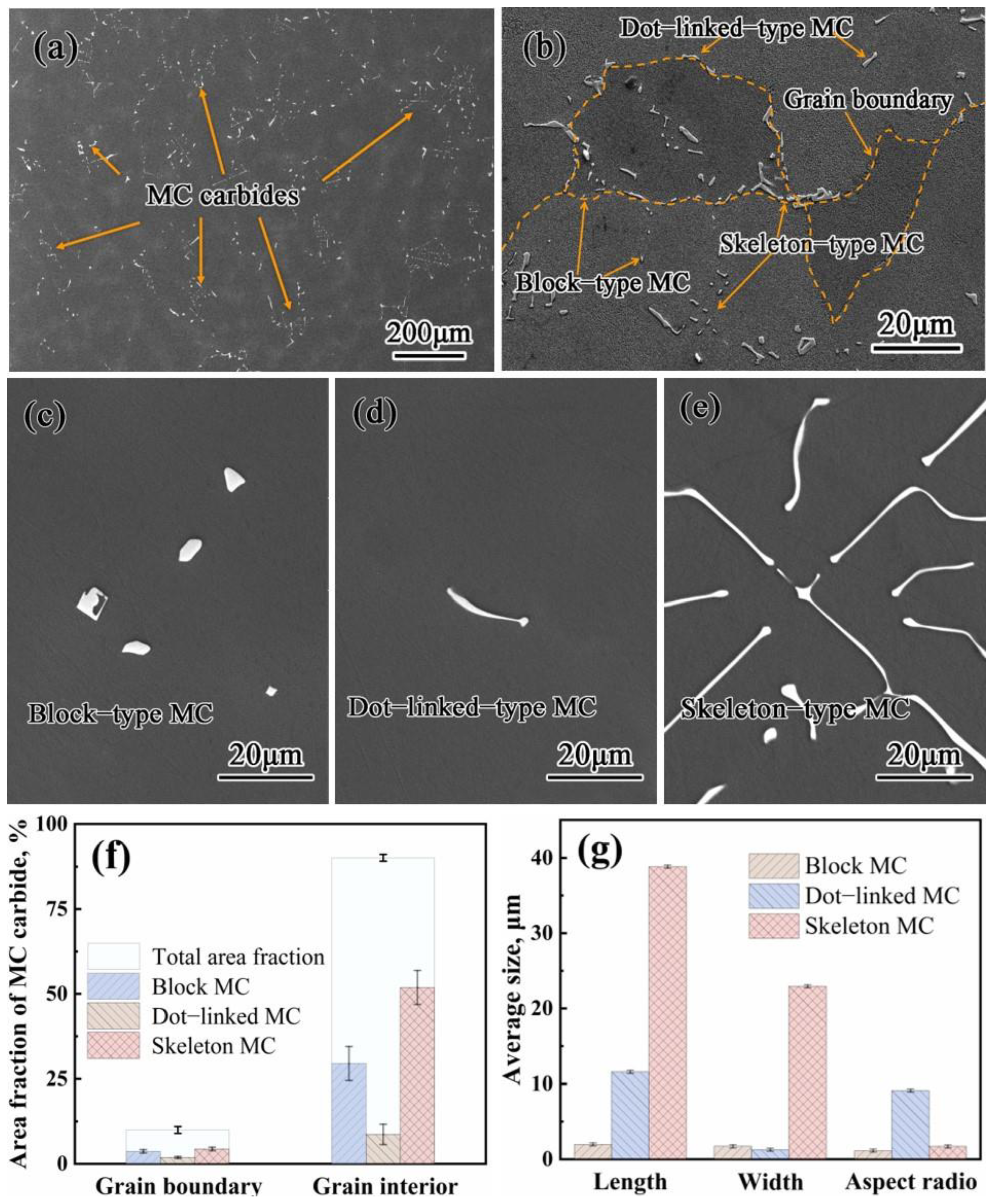
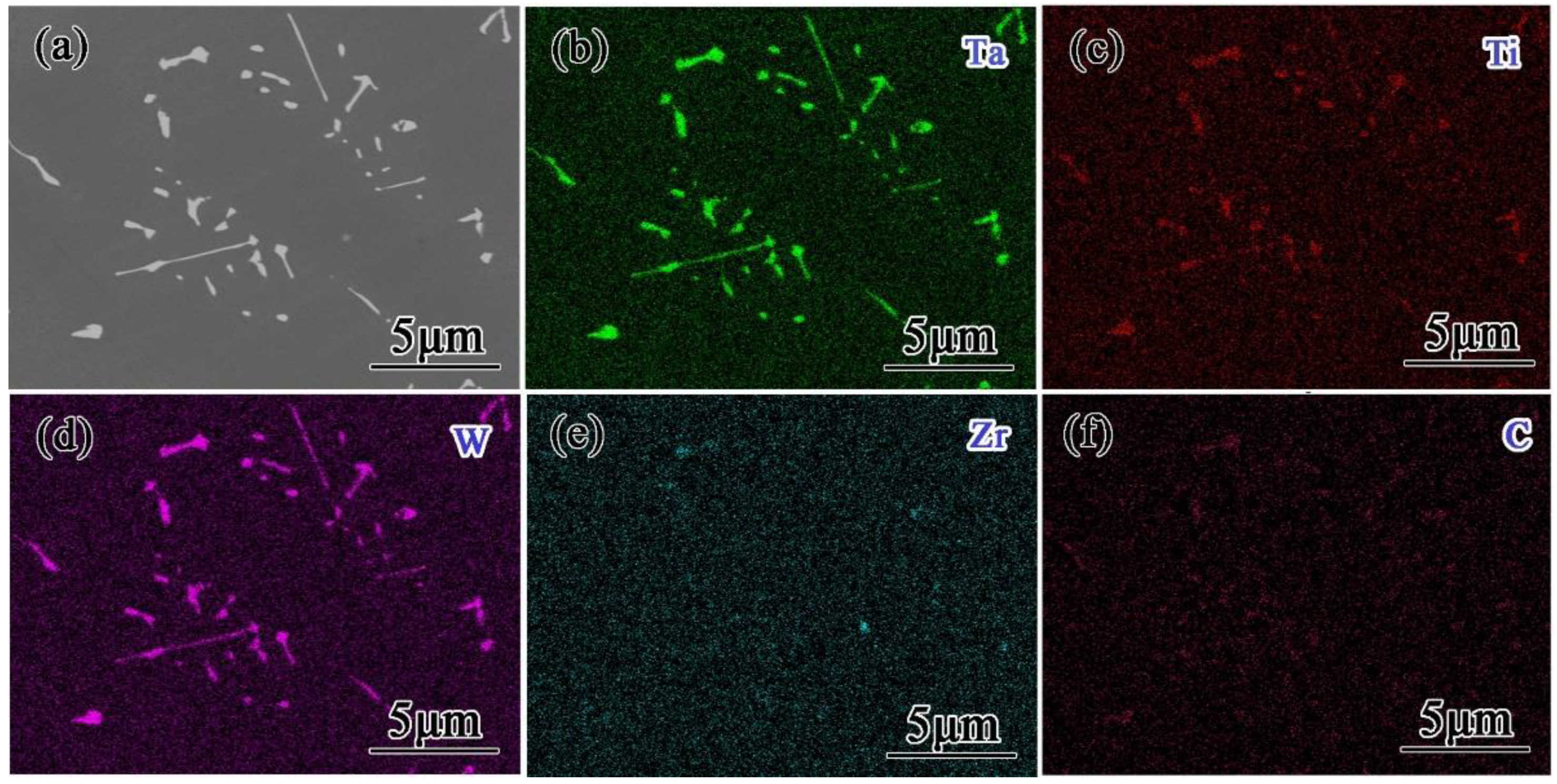
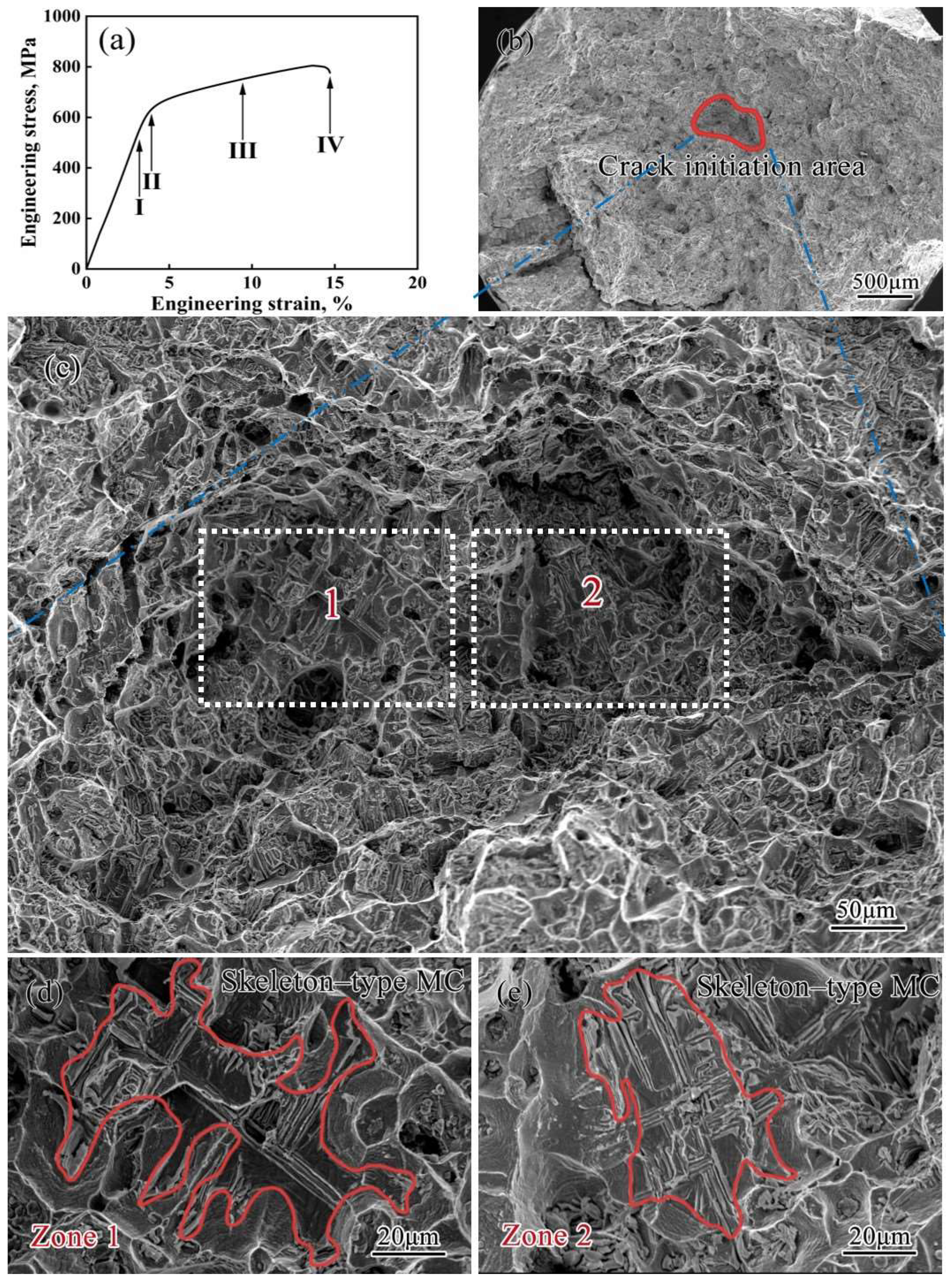
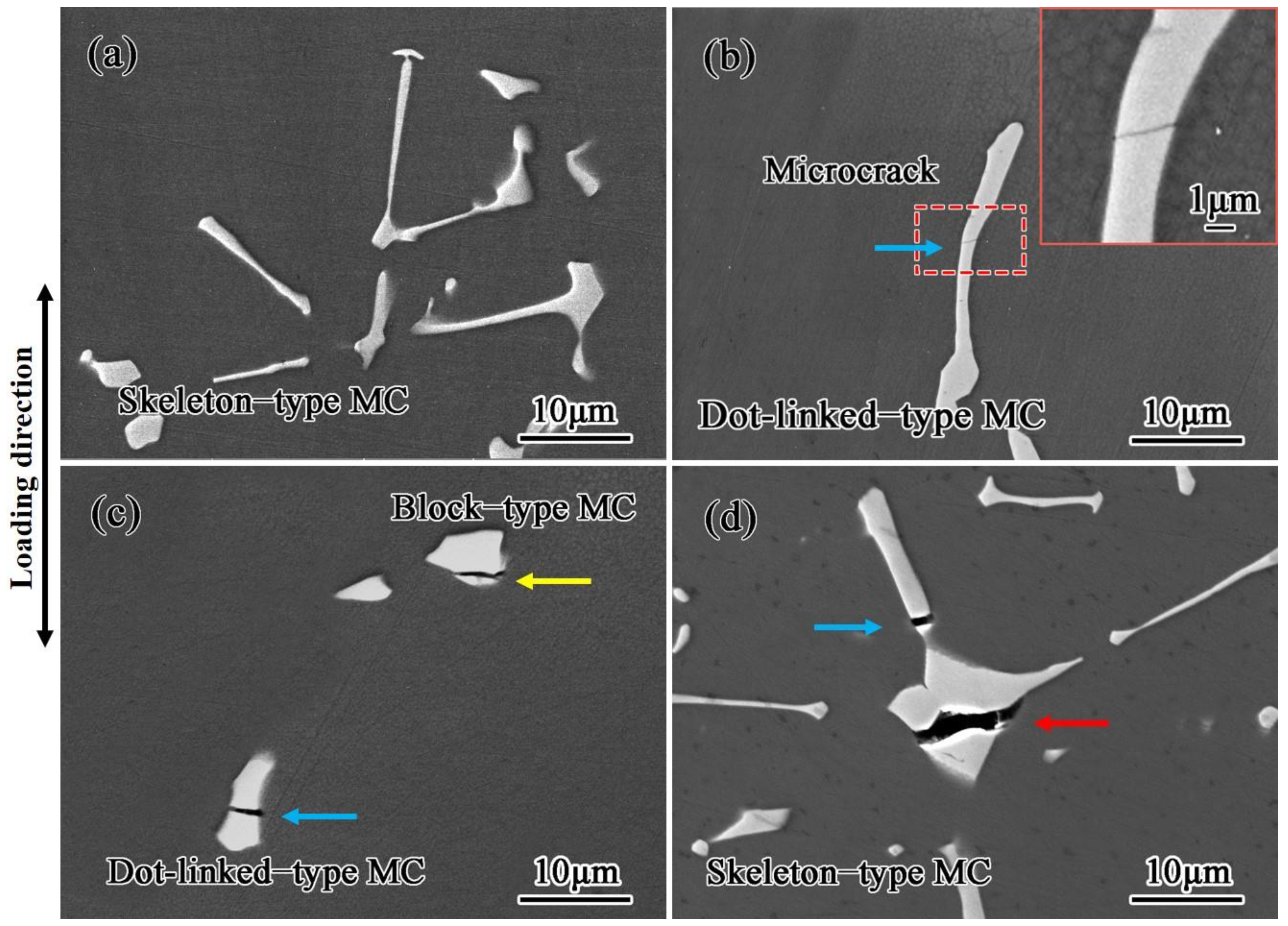

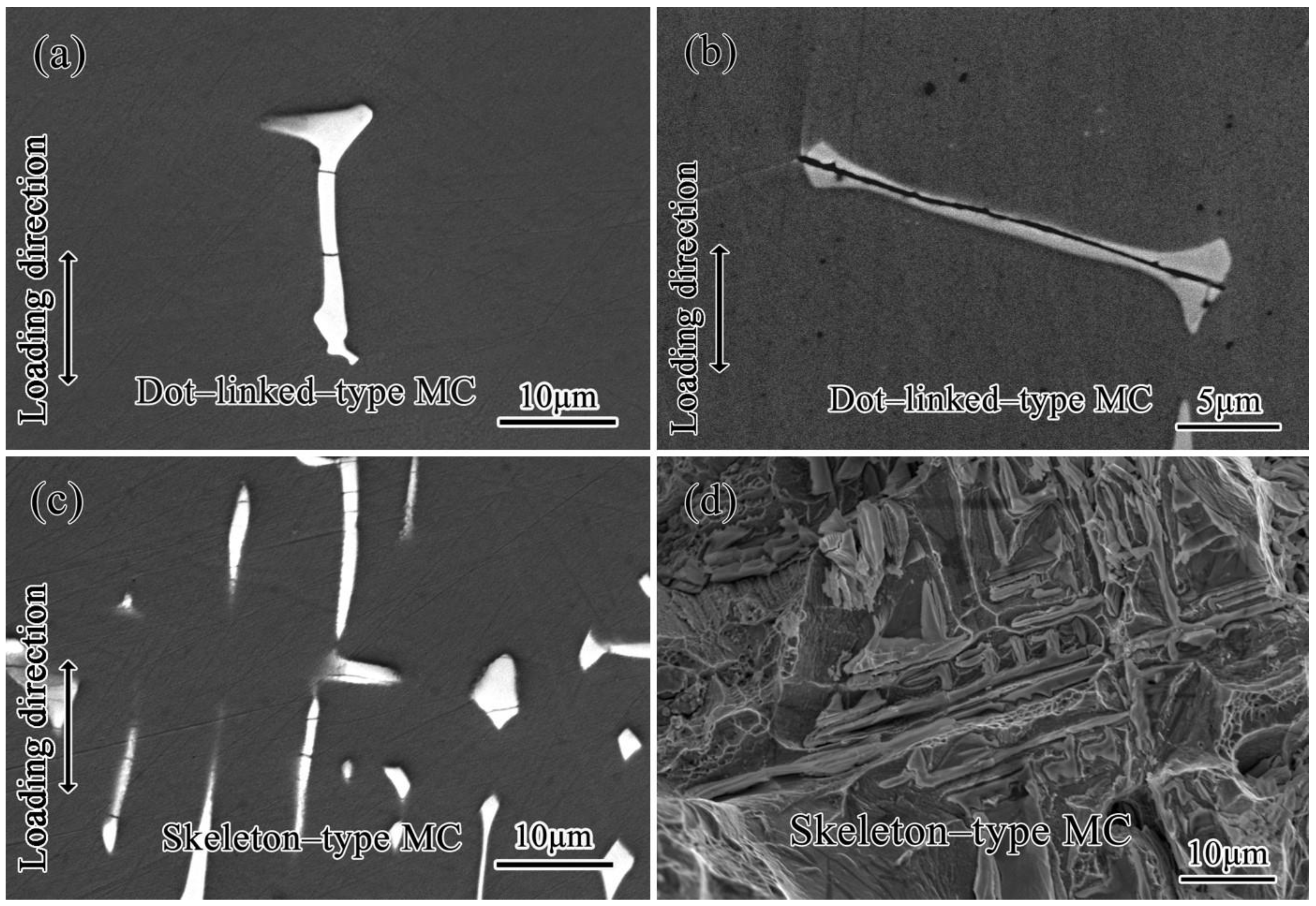
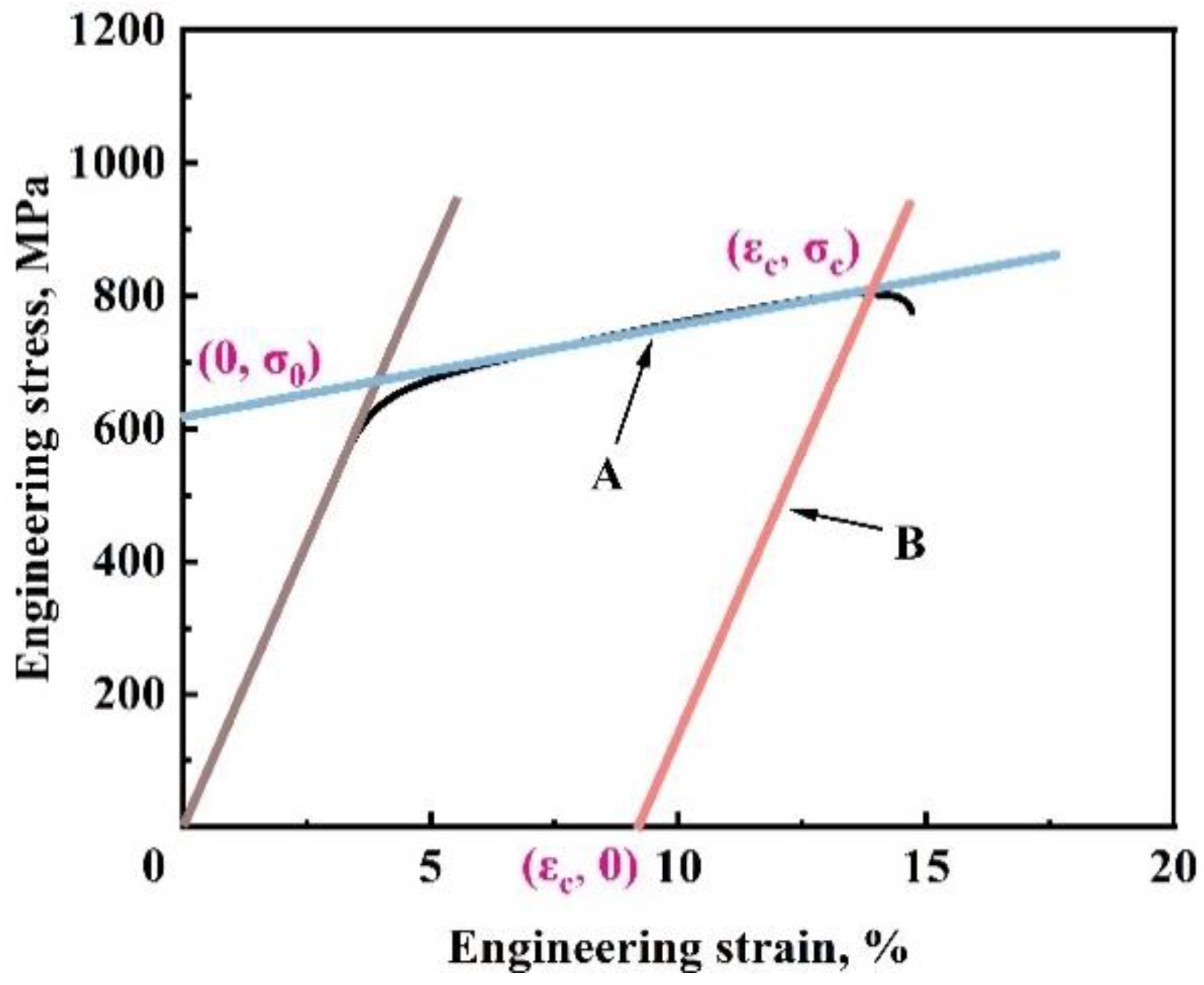
Disclaimer/Publisher’s Note: The statements, opinions and data contained in all publications are solely those of the individual author(s) and contributor(s) and not of MDPI and/or the editor(s). MDPI and/or the editor(s) disclaim responsibility for any injury to people or property resulting from any ideas, methods, instructions or products referred to in the content. |
© 2023 by the authors. Licensee MDPI, Basel, Switzerland. This article is an open access article distributed under the terms and conditions of the Creative Commons Attribution (CC BY) license (https://creativecommons.org/licenses/by/4.0/).
Share and Cite
Wang, H.; Wang, L.; Liu, Y.; Song, X. Improving Intermediate Temperature Plasticity of Co–Al–W–Base Superalloy: Based on Optimizing MC Carbides. Metals 2023, 13, 402. https://doi.org/10.3390/met13020402
Wang H, Wang L, Liu Y, Song X. Improving Intermediate Temperature Plasticity of Co–Al–W–Base Superalloy: Based on Optimizing MC Carbides. Metals. 2023; 13(2):402. https://doi.org/10.3390/met13020402
Chicago/Turabian StyleWang, Hongwei, Lei Wang, Yang Liu, and Xiu Song. 2023. "Improving Intermediate Temperature Plasticity of Co–Al–W–Base Superalloy: Based on Optimizing MC Carbides" Metals 13, no. 2: 402. https://doi.org/10.3390/met13020402




